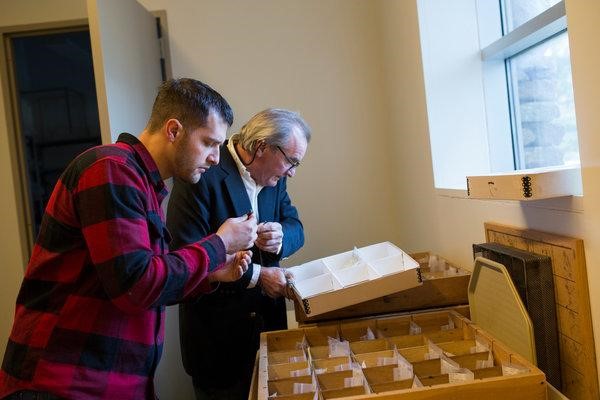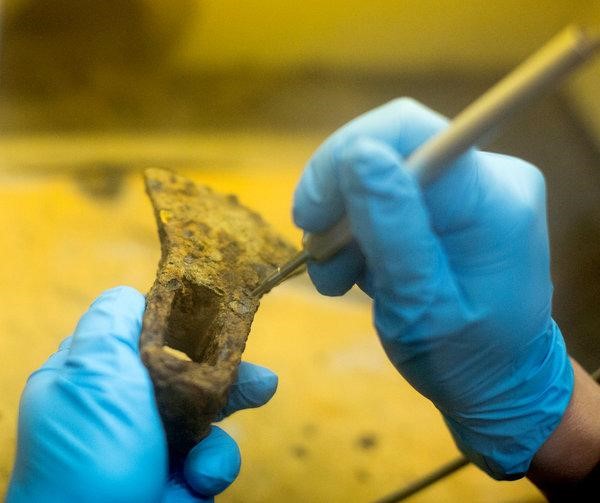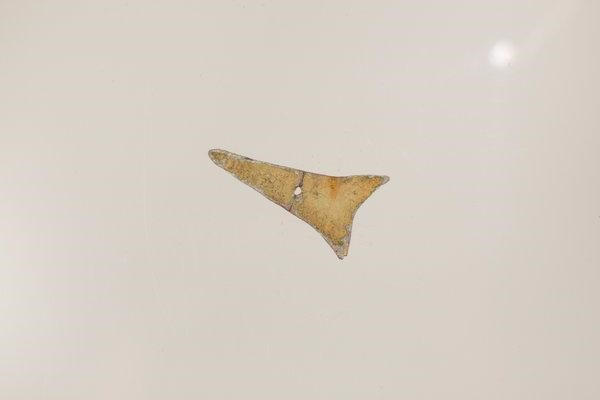By Tyler J. Kelley
Jan. 16, 2017
NEW LONDON, Conn. — Keith Wille was metal detecting in the woods of Connecticut a few years ago when he found a triangle of brass about two-and-a-half inches long with a small hole in the middle. He thought little of the find at first, and threw it in his scrap pile. Mr. Wille, 29, is a manager at a survival training company, but spends most of his spare time metal detecting.
In September, Mr. Wille drove from his home here to the with several boxes of objects — the highlights of his recent collecting. The museum — a vast, glassy structure that looks like an airport terminal, complete with a 185-foot-tall traffic-control-style tower — is a testament to the years when the Foxwoods Resort Casino made the Pequots the wealthiest tribe in the nation. Although those fortunes have declined, the Pequots are still financing projects by the archaeologist Kevin McBride, who works full time on what Lori A. Potter, a spokeswoman for the Mashantucket Pequot Nation, called “history that’s written by the conquered and not by the conqueror.”
Inside the museum, Mr. Wille unpacked his boxes, displaying items discovered around the Pequots’ homeland: George Washington inaugural buttons, musket and cannonballs, a gold ring, commemorative spoons, a 100-year-old military insignia, and the triangle of brass.
Dr. McBride, the museum’s director of research, and David J. Naumec, its senior historian, inspected the lot, but were most curious about the crude brass triangle. They knew it was a kettle point, an arrowhead fashioned from a piece of a brass trade kettle (which resembles a pail) — an archaeological signature of the 17th century.
The two scientists were finishing a seven-year project documenting the Pequot War of 1637, especially the running battle the English fought as they retreated to their ship, after massacring the Pequots at Mistick Fort.
Metal Detectorists Help Archaeologists Dig Up a Secret History

Keith Wille, a metal detectorist, walks in the Connecticut woods where he has found artifacts. Christopher Capozziello for The New York Times

Keith Wille, left, examines artifacts with the archaeologist Kevin McBride at the Mashantucket Pequot Museum and Research Center. Christopher Capozziello for The New York Times
Many archaeologists consider metal detectorists looters who shouldn’t be allowed anywhere near their labs or dig sites, but Dr. McBride has a different view.
“It’s a real ongoing debate in the profession,” he said. “To what extent do we embrace hobbyists or amateurs? You’re not going to stop them so … join them.”
At first, Dr. McBride and Mr. Naumec tried to do some metal-detecting themselves on the battlefield in 2008. “We figured it wasn’t rocket science,” he said. But they learned that while it’s not hard to find a dime lying on the floor, it takes years of practice to recognize the sound of a musket ball eight inches underground and then determine its provenance.
The scientists then reached out to local metal detecting clubs and formed an unconventional alliance with several detectorists, deputizing a few citizen-scientists who already spend free time looking for what archaeologists want. With so many significant Pequot war-era sites still undiscovered, the relationship has begun to produce results.
The metal-finding enthusiasts tend to be wary of archaeologists and authorities in general, who might restrict their access to a place or take away their finds. Yet when one detectorist, George Pecia, started working with the archaeologists, he realized they could benefit each other. The detectorists get to search areas otherwise off-limits and “piece together a mystery, which is what detecting is about,” Mr. Pecia said, and the scientists get an efficient way to find anything metal.
He and others scanned the dig sites, and Dr. McBride paid them through a grant from the National Park Service’s American Battlefield Protection Program that funds his fieldwork. “We call them Jedi masters,” Dr. McBride said, pointing out that detectorists had found about 80 percent of the artifacts cataloged in the project. “Even with the most intense digging, we would have found about 5 percent or less of the objects recovered through metal detecting,” he said.
At the lab, Mr. Wille told the archaeologists about scraps of brass and lead he found close to the kettle point. Nearby, he also struck a layer of shells and two stone arrowheads. “Man, we got to check this spot out!” Mr. Naumec said. “Brass scrap gets us excited. We look for a weird lead — the shells!”
“That’s a huge signature,” he explained. “A shell heap or shell midden — it’s basically their trash.”
In late November, Mr. Wille led Dr. McBride to where he had found the kettle point, a high, level spot now entirely covered with brambles and small oak trees. Dr. McBride logged the situational details of the find in his iPad.
The site got him thinking about the months and years after the English defeated the Pequots. The survivors were handed over to the Mohegans and Narragansetts, the Pequots’ traditional enemies who fought with the English. It was “basically cultural genocide,” Dr. McBride said. Men were beheaded, women sold to other English colonies. The postwar treaty specified: “You shall no longer be called Pequot.”
Those given to the Mohegans were resettled, away from their traditional homeland, in five villages. A 1638 letter from Roger Williams, who founded Rhode Island, to John Winthrop, governor of the Massachusetts Bay Colony, said that four of the five villages were by the Thames River near present-day New London. The precise locations of the villages, which were occupied from 1638 to 1651, were unknown.
Crouching over his iPad, the archaeologist looked up at Mr. Wille and said, “I think you’ve got one.”

A technician at the Mashantucket Pequot Museum and Research Center removes rust from an adze found by Keith Wille. Christopher Capozziello for The New York Times
“The adze, the point, brass scrap — to me, it’s highly suggestive of one of those villages,” said Dr. McBride, listing other artifacts Mr. Wille had found in the area, especially an iron adze. A burial from the early 1600s had also been discovered nearby. “It all kind of fits,” he said. “We always had a sense they’re along the river, but I never, never, thought I’d be standing on one.”
Mr. Wille may have discovered “the first forced resettlement” of a native people, Dr. McBride said. The site predates Mashantucket, the first Native American reservation that was established in 1666, where the Pequot museum now sits.
If this spot had not been found until now, and it took a metal detectorist to find it, Mr. Wille asked: Would it sway the negative opinion that other archaeologists have of metal detectorists?
“No,” Dr. McBride said, but added: “We’ve done modeling. You can dig forever and not find the stuff you found in, what, a couple of hours?”
“I found the kettle point the first time I was here,” Mr. Wille said. “I probably spent two hours.”
The two men walked downhill to where the adze, a cutting tool with an arched blade, was found. Mr. Wille fetched his detector from the car, wanting to use the remaining daylight to search the area more thoroughly.
Dr. McBride knelt to log the location.
The difference between archaeology and looting, explained Brian Jones, Connecticut’s state archaeologist, is the recording of context. Detectorists tend to be “focused on the things,” Dr. Jones said, adding, “Artifacts are important to archaeologists, but really only in the story they tell, and you can’t tell the story unless you know where things are found.” Many detectorists mean well, but if an object is removed from its surroundings without a detailed survey of the area, the story is lost, Dr. Jones said, “and it’s really just looting.”
Keith Wille, a metal detectorist, walks in the Connecticut woods where he has found artifacts. Christopher Capozziello for The New York Times
Keith Wille, left, examines artifacts with the archaeologist Kevin McBride at the Mashantucket Pequot Museum and Research Center. Christopher Capozziello for The New York Times
A technician at the Mashantucket Pequot Museum and Research Center removes rust from an adze found by Keith Wille. Christopher Capozziello for The New York Times
An arrowhead fashioned from a brass trade kettle. Christopher Capozziello for The New York Times
19th Century Gold Chetelaine Found!
Valuable Silver Coins Found!
Reuniting people with lost possessions and the thing that means the most to them. Is there something you've lost?
Diamond Ring Found!
Lost Ring Niantic CT... Found!
This is why some archaeologists “start tearing their hair out and turning red” when approached by detectorists, he said. “A lot of important archaeological sites have been damaged beyond any future scientific use by metal detectorists,” Dr. Jones said. But he complimented Dr. McBride’s work, noting that it was in the vanguard of archaeologically responsible metal detecting.
“Ninety-percent of what is out there has never been found; we don’t have time to be out looking for sites,” Dr. Jones said, adding that much of his time was spent trying to preserve known historic sites from development. The majority of finds, then, will either stay in the ground or be discovered by amateurs.
When Mr. Wille returned with his detector, he set it to find large pieces of iron, at Dr. McBride’s suggestion. Within 10 minutes the machine made a loud squeal. Mr. Wille jabbed his shovel in a circle and pulled out an eight-inch-thick plug of earth. Digging a bit more and using a vibrating pinpointer, he extracted a flat oblong piece of iron about four inches long, wider and curved at one end, flat on the other.
He handed it to Dr. McBride, who brushed the dirt off and looked closely. “That’s worth an X-ray,” he said. “It vaguely resembles the shapes we see in other sites.” It looked like a tool, possibly traded to the Pequots, or repurposed by them. Dr. McBride said he would like to check it against finds from Jamestown Fort in Virginia or Plymouth, Mass., both contemporaneous sites. “An intriguing shape,” he said.
Dr. McBride says there is a “better than even” chance that Mr. Wille discovered the site of Tatuppequauog, one of the villages mentioned in the 1638 letter. The letter said it had 20 houses; Dr. McBride estimated that about 200 people might have lived there, a large enough village to account for the distance between where the adze and kettle point were found.
If it is Tatuppequauog, Mr. Wille would be listed as the discoverer. While he displayed little emotion that afternoon during the search, afterward he was ecstatic that his past time might contribute to history. “You become a part of something bigger than filling your cabinet with musket balls and belt buckles,” he said.
A version of this article appears in print on Jan. 17, 2017, on Page D1 of the New York edition with the headline: Finding Common Ground.

Consultation & Metal Detection Service
Keith Wille
